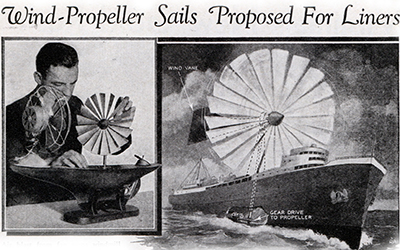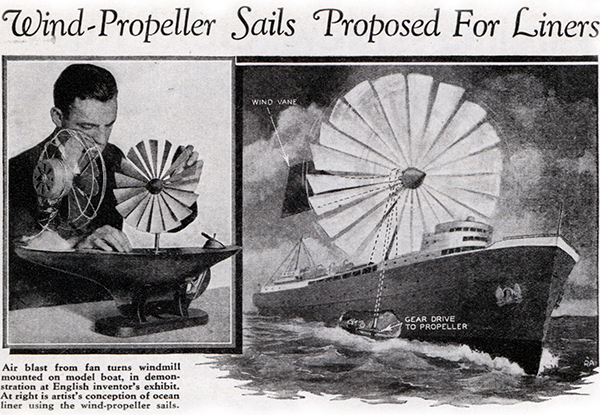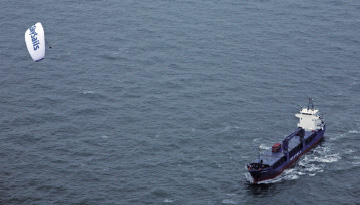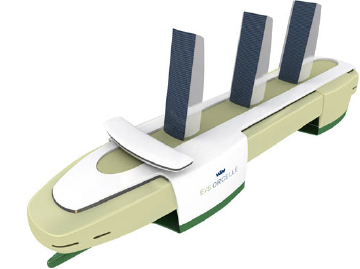Well-spotted that big riverboat wheel


Blast From the Past: Windmills, to propel ships, are being disdained by leading windmill-maker Enercon. Modern Mechanix January 1935
Master mariner Melvyn Bowen warmed up his audience with a quiz.
‘Where am I?’ he asked of the dozen or so who turned out on Friday evening to hear from the commercial sail aficionado.
The first image of the presentation was of Melvyn stood in a wheelhouse featuring a wheel of particularly large diameter, and a polished brass telegraph in the foreground.
The answer was provided by long time Mahurangi Regatta director:
Even for a big wheel in matters maritime—ex chief engineer of trans-Tasman roll-on-roll-off ships—Michael Gordon’s identification of the vessel from the clues provided by the wheelhouse was impressive.
Also impressive was Melvyn Bowen’s experience. And the audience might have better-justified Melvyn’s journey from Rotorua had it been swelled by those who might have been attracted by one particular commission: Captain of the Charlotte Rhodes of The Onedin Line fame. For many, the strains of the theme music—from the uniquely stirring ballet by Armenian-born Aram Khachaturian—lasted the evening, even in the absence of a sound track.
And those too young to have hung on every episode of The Onedin Line might have been motivated by a subsequent commission Melvyn secured: Captain of the replica of HMS Bounty built in Whangarei (and under-budget) for the 1988 film.
After a brief history of commercial sail, Melvyn covered various areas of wind power development, none of which have been convincingly implemented, as yet.
The use of wind turbines has been demonstrated, including by Jim Bates of Whangarei.

Beyond Flying a Kite: SkySails is continuing to test and develop these outrageously big kite sails and are champing at the bit to green your super motor yacht with the same technology! photograph SkySails (logo added to image)
The resultant vessel could not be described as handy—the term Melvyn Bowen said was used to describe the Cook’s Endeavour and Bligh’s Bounty, in spite of their inability to sail to windward. Mechanical engineer Bob Mertens described Bates, filmed operating his craft, as ‘busier’n a cat covering up poop’.
No doubt a much-handier vessel could now be built using electric drive technology developed for hybrid cars. But it is possibly instructive that Enercon, the world’s third largest wind turbine manufacture, does not plan to use turbines on its own turbine delivery ship.
Instead, it is using a system prototyped by aircraft designer Anton Flettner 1920s whereby smooth-surfaced vertical cylinders rotated by engines employ the Magnus effect to produce lift at right angles to the apparent wind.
But Bowen is not holding his breath, and shares SkySails’ vision that the future of commercial shipping lies with the deployment, on an audacious scale, of the wild sails that have kiteboarders whipping back and forth—the contemporary spectacle of Ōrewa Beach.
But back and forth is the undemanding wind-on-the-beam sailing that sailors used to refer to as a soldier’s wind. When it comes to sailing higher on the wind that the 50° that kites apparently allow, a modern implementation of the sailing ship rig is suggested—for example, the DynaRig.
The DynaRig was conceived by Wilhelm Prolls at Hamburg University in the 1960s, in response to the impending oil price shock. While the rig has yet to be fitted to a cargo carrying ship, it has been impressively implemented to a yacht the size of a small ship, Tom Perkins’ Maltese Falcon.

Zero Emission Shipping: While its easily-driven canoe hull (hidden below the sponson upper hull) slides through the seas, wave action would be converted to forward thrust. image Wallenius Wilhelmsen
Presumably a large part of the $200 million spent building the Maltese Falcon went into research and development—the masts have a built in system for minutely and continuously monitoring rig loading. But if the rigs were manufactured, as opposed be bespoke produced, this might provide the ultimate a high profile green means of delivering high quality Aotearoa wine to Europe—bottling only performed at the northern end, of course.
Strangely absent from Bowen’s presentation was the radically innovative Wallenius Wilhelmsen concept ship, the Orcelle.
The concept proposes a narrow but broadly-sponsoned hull with banks of horizontal fins at each quarter that convert wave action to forward motion.
Three rather vestigial-looking wing sails also serve as a photovoltaic collectors, and fold flat on deck, presumably in a calm or motoring into the eye of the wind.
Like the SkySail ships, primary power is not from sail. The Orcelle’s would be hydrogen-driven fuel cells.
Primary drive is by two puller propellers that, by being set below the main hull, obviate the need for that notorious pollutant, ballast water.
The vessel is designed to deliver a staggering 10 000 cars, which will possibly give those of ‘car bad; public transport good’ persuasion pause. However, the cars that the Orcelle will deliver, from its projected 2025 implementation, will be a far cry from the fossil fuel villains of today.
The company does appear to be serious in its zero emissions direction. Its latest carrier, the Oberon, which can deliver 8000 cars, boasts a groundbreaking ballast water treatment system, and incorporates myriad refinements, including a twisted leading edge flap-rudder, to achieve a 20% fuel reduction.
A treat Melvyn Bowen clearly hadn’t appreciated when he displayed an image of her, was being able to inspect, the following morning, the reconstructed scow Jane Gifford herself.
Perhaps it is time for some big wheel currently responsible for the rigs that flog the highways of Aotearoa to emulate Wallenius Wilhelmsen—to design a concept vessel capable of transporting half a dozen containers coastwise, in the spirit of the scows.
